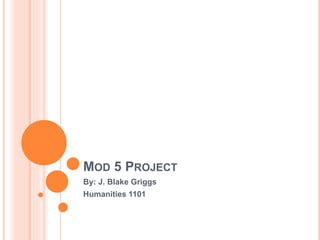
Mod 5 ppt
- 1. MOD 5 PROJECT By: J. Blake Griggs Humanities 1101
- 2. NAME 5 WORKS DEFENDING… “The Enlightenment marks the divide between an essentially medieval view of the world as dominated by divine truths and the principals of religious faiths, and the modern view of the world as governed by scientific truths and the principals of human reason.”
- 3. NEW ASTRONOMY : BY JOHANNES KEPLER German mathematician who argued that the magnetic force emitted from the Sun determined the movement of the planets and their perspective distances from the Sun (Fiero 294). “Theorized” Heliocentricity, contrary to the traditional belief that Earth was the center of the universe. “Kepler was convinced there was a similar set of ratios that defined the movements of the heavenly bodies. Kepler called this idea "world harmony," and his lifelong attempt to understand its inner workings led to the discovery of his three laws of planetary motion. These laws provided theoretical support for the idea of a Sun- centered universe and a moving Earth, and became a critical part of modern astronomy.” (Johannes, retreat into studies).
- 4. NEW ASTRONOMY : BY JOHANNES KEPLER Galileo Galilei took Kepler’s Theory, and with the perfection of the telescope, turned the theory of heliocentricity into fact. Galileo used the telescope and observed that the moons of Jupiter orbited the planet, just like Earth’s moon did. This brought strict criticism on Galileo from the Catholic church. Charges were brought upon him and his research was deemed Heresy. “Theologically speaking, heliocentrism was declared formally heretical, on the grounds that it was explicitly contrary to Scripture” (Finocchirao 9).
- 5. PRINCIPA MATHMATICA: BY ISSAC NEWTON Linked Terrestrial and Celestial Physics under a single set of laws. Newton’s Laws of Motion, and the Law of Universal Gravitation. Suggested the idea of a uniform and intelligible universe that operated as systematically as a well- oiled machine (Fiero 297).
- 6. PRINCIPA MATHMATICA: BY ISSAC NEWTON Became a cornerstone piece of the Scientific Revolution. Findings went unchallenged until the late 19th Century (Fiero 297). Inspired many others to start investigating and applying scientific knowledge to the natural world, where previously the only answers provided came from religion. “Nature and Nature’s Laws lay hid in Night. God said, Let Newton be! And all was light.” –Alexander Pope
- 7. ENCYCLOPEDIE: PUBLISHED/EDITED BY DENIS DIDEROT Denis Diderot was apart of a group called The Philosophes. The Philosophes (The Philosophers) were a group of French “Thinkers” who applied scientific models and the empirical method to all aspects of human life (Artz 30-31). “Knowledge took the place of grace, and the Philosophes appealed to all reasonable men to overthrow the ideas handed down from the past and to accept the rule of reason” (Artz 30).
- 8. ENCYCLOPEDIE: PUBLISHED/EDITED BY DENIS DIDEROT First Time in history that all the research from around the world was compiled together and mass produced. Made true Knowledge available throughout all of Europe. The Government ordered the 2 volumes be discontinued and forbade the makings of any other sequential volumes (Artz 91). The order read….. "His majesty has recognized that in these two volumes they have presumed to insert several maxims tending to destroy royal authority, to establish the spirit of independence and revolt, and, beneath obscure and equivocal terms, to raise the foundations of error, moral corruption, irreligion, and incredulity“ (Artz 91).
- 9. A VINDICATION OF THE RIGHTS OF WOMEN: BY MARY WOLLSTONECRAFT Attacked the persistence of the female stereotype. Called for a “Revolution of Female Manners” (Johnson Ch. 9). Inspired a movement that was the first step to equality for women. “Wollstonecraft argued that females are in all the most important aspects the same as males, possessing the same souls, the same mental capacities, and thus the same human rights”(Johnson Ch. 9).
- 10. ECONOMIC TABLE: BY QUESNAY Used Reason, and applied it to Economics. Defined 3 social classes and set guidelines that each class should abide by. explained how wealth was distributed throughout society determined the overall economic health of the community. Called for less Governmental interference and regulation; “Free Enterprise”. With his success, He influenced other Ruler’s to adapt his philosophy; therefore changing the way Economics was thought about.
- 11. IMAGES CITED www.google.com/images Microsoft Office 2007 Clip Art.
- 12. WORKS CITED Artz, Frederick Binkerd. The Enlightenment In France. Kent, Ohio: Kent State University Press, 1998. eBook Collection (EBSCOhost). Web. 18 June 2015. Fiero, Gloria K. Landmarks in Humanities, 2nd ed. Boston: McGrawHill,2009. Print. Finocchiaro, Maurice A. Retrying Galileo, 1633-1992. Berkeley: University of California Press, 2005. eBook Collection (EBSCOhost). Web. 18 June 2015. "Johannes Kepler: Discovering The Laws Of Celestial Motion." Johannes Kepler: Discovering The Laws Of Celestial Motion (2003): 1-39. History Reference Center. Web. 18 June 2015. Johnson, Claudia L. The Cambridge Companion To Mary Wollstonecraft. Cambridge, UK: Cambridge University Press, 2002. eBook Collection (EBSCOhost). Web. 18 June 2015.